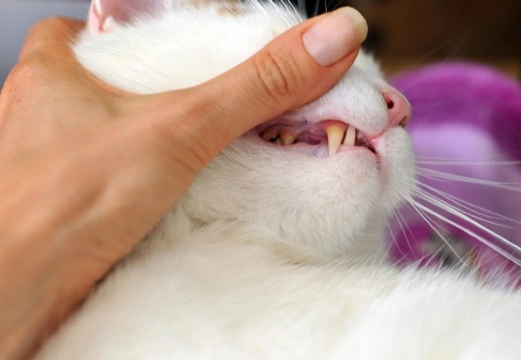
Dental Problems in Cats
Many cats are prone to dental disease and gingivitis, even from an early age, and it is important for cat owners to understand what can go wrong and how to deal with it.A cat should develop thirty teeth:
- twelve incisors - these are the tiny teeth at the front, six at the top and six at the bottom, which a cat living in the wild would use to hold its prey. In practice these very often fall out at a very early age, and are not missed.
- four canines - for shredding and tearing prey
- ten premolars - for chewing food
- four molars - also for chewing
The most common form of dental disease is caused by plaque and the formation of tartar, when the teeth turn a dark shade of yellow with the layer of plaque. Your Vet can remove this plaque under a general anaesthetic, and he may also advise the removal of badly affected teeth. It is a very difficult problem to avoid totally, and although many Vets will suggest cleaning your cat's teeth with a specially formulated toothbrush, in practice very few cats will actually allow you to do this. It is possible to buy an anti-plaque additive specially formulated for cats and dogs that can be added to their drinking water - but again, most cats will refuse to drink water with this in! Cats that eat dried food have less trouble with plaque and tartar as the hard chewing helps to keep plaque at bay, and if the problem is caught early on, it is more likely that the affected tooth or teeth will be saved. Gingivitis is often associated with excessive plaque and tartar, and makes the gums appear very red and sore, and often the first thing you will notice is the onset of very bad breath. The cat may also dribble or drool, and will find it quite painful to eat. It's a difficult condition to reverse, but can generally be resolved with the scaling and polishing of the teeth. The Oriental breeds seem to be most susceptible to this type of dental problem, and also cats that are paler coloured such as white, red, cream and apricot. Unfortunately, although good dental treatment is essential for the well being of any cat, very few insurance policies will pay for it and it will normally be excluded in your policy. Some of the more expensive policies will cover dental treatment, and it may be worth asking before you commit yourself to a policy, as most cats ultimately need dental treatment, and because of the anaesthetic involved, it can be quite costly. Gingivitis can also affect quite young kittens from around the age of around five months, but at this age it is usually caused by the second teeth coming through, a process which can take two or three months to complete. You will sometimes see two teeth in the same position, but the old tooth will usually drop out on its own (don't be alarmed if you find a few baby teeth on the carpet, it's perfectly normal!), or if the tooth is very loose, you can sometimes help it on its way by pushing it very gently. Again, if you have any concerns about your kitten's mouth, you should have him checked out by your Vet who may be able to prescribe something to help alleviate the discomfort. There are several other forms of dental disease that may affect your cat:Periodontitis - a gum disease visually similar to gingivitis, and often seen in older cats. The gums become very recessed and as the ligaments surrounding the tooth are also infected and often discharging pus, the only solution is usually tooth extraction. Stomatitis - inflammation of the oral cavity. This has many of the same symptoms as the advanced forms of gingivitis, but is far more painful and will prevent a cat from eating. This can sometimes be treated successfully with antibiotics and anti-inflammatory drugs, but it usually it involves a general anaesthetic to clean and remove the diseased teeth, ideally followed up by administering mouthwashes to reduce the bacteria. Where cats won't tolerate this, the after-treatment consists of further antibiotics and steroid treatment, and if it persists further, more teeth will need to be removed.Feline Odontoclastic Resorptive Lesions - these are infected cavities in the teeth caused by decay, and are very common in cats over the age of five years. Whereas in humans the equivalent problem would be resolved by a filling, in cats this isn't practical and the infected tooth will need to be removed. Even the identification of the problem has to be carried out under general anaesthetic as it is so painful, but if it is left untreated it would eventually lead to an even more painful root infection. A domestic cat can manage perfectly well without all of its teeth as it does not have to catch and process its own food, and it's vital that dental disease is identified and treated as soon as possible to avoid further discomfort to your cat. Your Vet will check your cat's teeth at annual check-up time, and if you show your cat, the vetting-in procedure will probably identify any problems. Nevertheless, it's very important to monitor your cat's mouth on a regular basis as cats can suffer from toothache too, and raise any concerns with your Vet as soon as possible before any problems progress too far. But don't worry too much if your cat does need to have a major dental - he will probably look a bit sorry for himself for about 24 hours, and then he will be right as rain as if nothing had happened, and will probably be very grateful to you for getting rid of his toothache so that he can enjoy his food again!



